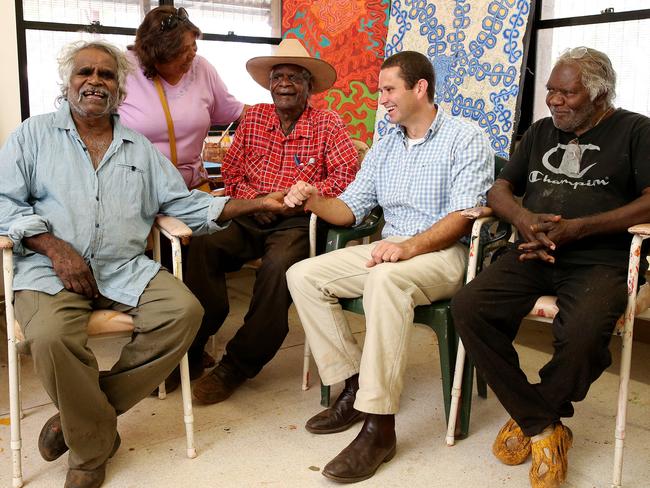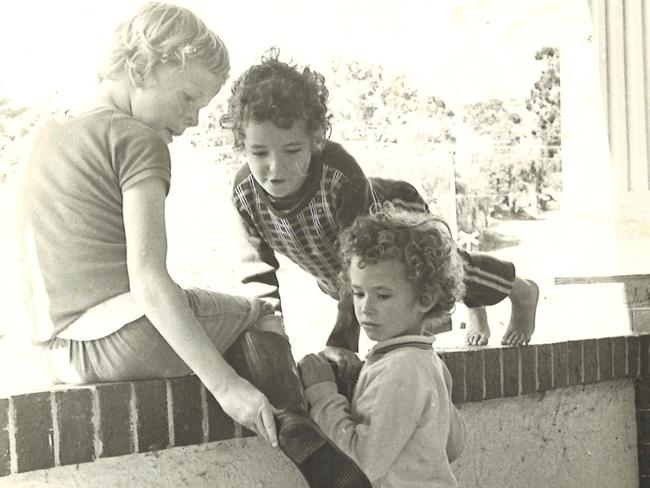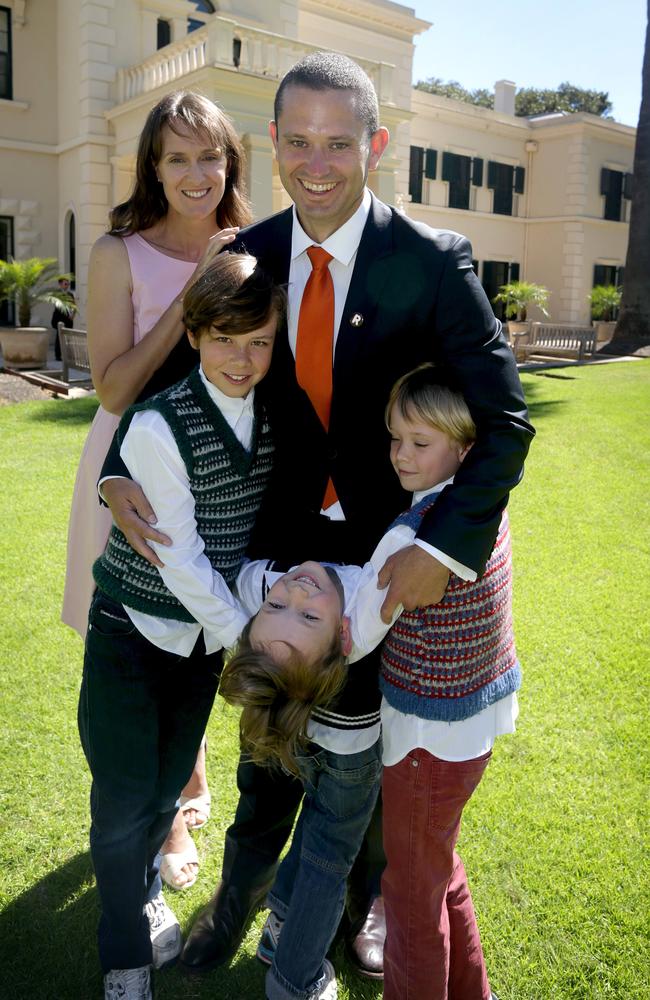Aboriginal Affairs and Reconciliation Minister Kyam Maher starting to reconnect with indigenous heritage
GROWING up in Mt Gambier, Kyam Maher was always aware of his Aboriginal heritage. But it’s only after visiting the APY Lands in recent times, that Labor’s rising star has forged an enduring connection with his culture.

SA News
Don't miss out on the headlines from SA News. Followed categories will be added to My News.
- Kyam Maher laments state of poverty and disadvantage in APY lands
- Lauren Novak: Fresh ideas needed to rid our APY Lands of poverty
- Opposition: APY Lands plan ignored for more than a decade
KYAM Maher shifts slightly in his office chair, pauses in thought for a second, and then, for the first time, talks publicly about his family’s Aboriginal heritage.
It’s never been a secret to Mr Maher or his family that his mum and country Labor stalwart Viv Maher is a descendant of Tasmanian Aborigines — but says it is a personal journey that only now he feels comfortable to freely talk about.
But once he starts, he has the distinct air of a man who is finally speaking words he has wanted to say in public for a long time.
“I don’t want to be unclear — I am extraordinarily proud that I have Aboriginal heritage and that I am an Aboriginal man,” Mr Maher says.
The affable Mr Maher has come a long way since his early life in Mt Gambier where he shone academically at the public Grant High School and enjoyed a happy and stable home life with parents Jim and Viv and two younger brothers, Cameron and Gibran.
Now Aboriginal Affairs and Reconciliation Minister among a swag of portfolios, Mr Maher swiftly emphasises that his early life was blessed compared to those of indigenous children throughout Australia.

“Many people experience extraordinary levels of disadvantage and racism while growing up but that wasn’t part of my growing up in Mt Gambier in the 1980s and early ’90s,” he says.
“It wasn’t the most diverse community in Australia; I reckon I had two Aboriginal friends growing up who went to Grant High School at the same time as me.”
Mr Maher left Mt Gambier, graduated from law and economics at the University of Adelaide and then worked as a lawyer for the Crown Solicitor’s Office before he shifted his focus to politics.
Not yet 30 when Mike Rann’s Labor started its lengthy and continued reign, Mr Maher became chief of staff to then-Aboriginal Affairs Minister, the late Terry Roberts.
That 2002 visit to the vast and remote Aboriginal lands left Mr Maher deeply affected, as Aboriginal communities tore themselves apart in a haze of booze, violence, poverty and petrol sniffing.
“Petrol sniffing was rife throughout communities. It was devastating communities — young men who were chronically brain-damaged through petrol sniffing, violence in communities, suicides by very young men,” Mr Maher recalls.
“My first visit to the APY Lands was exceptionally confronting, almost a bit overwhelming in terms of how can a government help?”
Modified OPAL fuel thankfully ended the petrol-sniffing scourge, while police and authorities have taken a tougher — though not foolproof — approach to keeping alcohol and drugs away from the 103,000sq km protected lands.

With a permit required to even enter the APY Lands, relatively few Australians have a concept of the isolation between the hauntingly beautiful yet unforgiving country and the rest of the world.
But arguably the greatest challenge, and the Anangu people themselves, is how to preserve what is the world’s oldest-surviving culture in symmetry with a western economy.
Anangu life and customs bear scant resemblance to any western culture, with seasoned travellers commonly remarking they had rarely felt more alien than when in such traditional and remote communities within Australia.
Mr Maher remains optimistic that living and health conditions for remote indigenous people will continue to improve beyond what remain shocking levels comparable to the poorest Third World nations.
He almost hisses his rejection of the notion by people — including former Prime Minister Tony Abbott — that remote indigenous peoples continued habitation of their traditional lands was no more than a lifestyle choice.
“A recent Prime Minister said that living in remote communities was a lifestyle choice — it’s not that, the connection between country, family and yourself ... there is no separation,” he says.
“We should be extraordinarily proud that we are in a country that boasts the oldest-living culture in the world and here, in the far northwest of South Australia, we have descendants from thousands of generations whose culture is so strong and so apparent — but with that comes extraordinary challenges.
“When changes are as recent as one lifetime away, more than 40,000 years of culture is now clashing with one that is reasonably new.”

Family and cultural obligations are sacrosanct, time as most understand it is not really much of a thing, and things as simple as minimal eye contact and animated general speaking volume are but a few of the unique features of Anangu culture.
Most Anangu speak Pitjantjatjara or Yankunytjatjara and English is generally a second, if not third, language.
Mr Maher, who visits the APY Lands several times a year, has the obvious respect of elders, and completed a two-week intensive course in Pitjantjatjara and used the local dialect to thank Fregon elders for their hospitality in a community Cabinet visit to the region earlier this month.
Despite a self-appraisal of his translation as rusty, it was clear the Aboriginal elders respect Mr Maher for immersing himself in their world and showing respect and understanding.
After becoming minister, Mr Maher packed his three sons — Marley, 11, Flynn, 9, and Jai, 7 — into a four-wheel-drive and drove them through what he describes as “hauntingly beautiful and remarkable” terrain.
His sons went to a community school with local children for several days and said every time he returned he was bombarded with questions why he had not brought his boys along.
“It was a remarkable experience for my kids to be involved in — and to be immersed in — Anangu culture but it was also something valuable in terms of family,” he says.
“Family is just so central for Anangu people that while, for me, being in a community with my family meant a lot to me, I think it also meant a lot to the Anangu people too that I took my kids to learn about their life and culture.”
Mr Maher said he had spent his fatherhood so far instilling a sense of pride in his boys about their Aboriginal heritage.

He credits former Labor Prime Minister Paul Keating’s landmark 1992 Redfern speech acknowledging that the near-wholesale destruction of Aboriginal traditional culture and lands by European settlement started a path towards a greater sense of indigenous pride.
“I think it’s something that, over the decades, has become something that people have felt more comfortable being proud of,” he said.
“We are becoming increasingly more accepting and I think people are becoming more comfortable displaying and being proud of Aboriginality and culture and that’s a very good thing.”
Mr Maher still regularly visits his old home town of Mt Gambier and his parents Jim and Viv, who was awarded a lifetime NAIDOC Day accolade last year, and has become a prominent leader of the local indigenous community.
He gets a thrill from seeing a greater recognition of Aboriginal culture and history in places such as Mt Gambier.
“When I’m walking around in Mt Gambier and to have young Buandik and Ngarrandjeri kids come up to my Mum and say ‘hey, Aunty Viv’ and to know that you have that link to the oldest living culture in the world is something extraordinary,” he says.
“Political insiders” — the parliamentary equivalent of trackwork watchers at Flemington — are tipping big things from the rangy colt from Mt Gambier.

His parents are both well-respected and Labor “true believers” who have contested frankly unwinnable elections as candidates in a staunchly conservative electorate.
Mr Maher has already ascended to lofty heights for someone in his early 40s, and barring monumental stuff-ups or scandals — which seem unlikely given his family man demeanour — he will be part of the SA political landscape for many years to come.
He’s chilled, charming and retains a bit of his inner kid, but Mr Maher is nobody’s fool.
He’s not easily angered or flustered and is unlikely to ever be lumped with a moniker of “firebrand” or “headkicker”.
But that quiet, patient and affable approach — in the post-Keating world largely devoid of verbal warfare — could land a canny politician in the top job. Just ask Premier Jay Weatherill.
Mr Maher would bristle at such long-range forecasting and is far too smart to entertain such personal aspirations publicly if he, indeed, has such ambitions.
But the mantle of becoming SA’s Australia’s first Aboriginal Premier is hardly beyond the realms of fantasy in the coming years.
Almost worth a fiver at good odds, some North Tce form-watchers might say.


